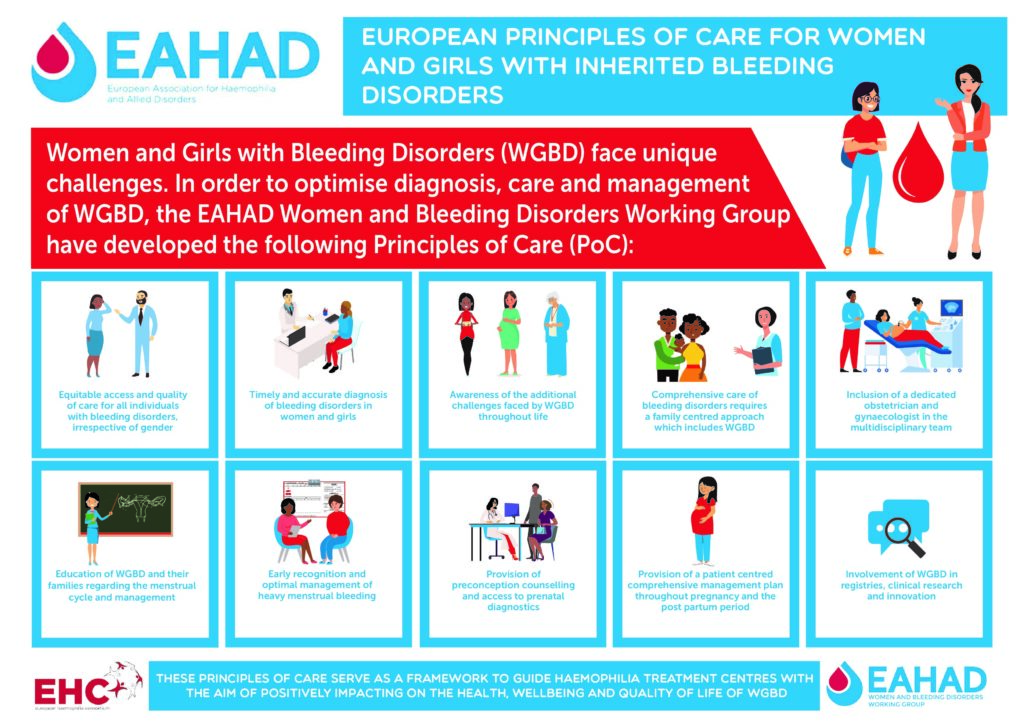European Principles of Care for Women and Girls with Bleeding Disorders
The 10 principles of care listed below serve as a benchmark for diagnosis and comprehensive multidisciplinary management of women and girls with bleeding disorders and improve awareness of their unique challenges.
The principles are results from work led by a multidisciplinary working group composed of the Committee on Women and Bleeding Disorders of the European Association for Haemophilia and Allied Disorders (EAHAD) and members of the EHC Women and Bleeding Disorders Committee. They offer a framework to guide haemophilia centres in providing equitable care for all women and girls with bleeding disorders, both in their own services and in other healthcare settings.
Implementation of these principles aims to positively impact the health, wellbeing and quality of life for women and girls with bleeding disorders, along with equitable access and quality of care for all individuals with bleeding disorders, irrespective of gender.

What does this mean?
- Equitable access and quality of care for all individuals with bleeding disorders, irrespective of gender
- Ensure access to care for both female-specific and general bleeding symptoms
- Appropriate multidisciplinary care, treatments and counselling
2. Timely and accurate diagnosis of bleeding disorders in women and girls
- Education of Public and Healthcare Professionals of normal and abnormal bleeding patterns
- Clear referral pathways
- Systematic approach to identification and testing of female carriers
- Registration with Haemophilia Centres
3. Awareness of the additional challenges faced by WGBD throughout life
- Psychological support for bleeding symptoms
- Improved medical management
- More effective self-management
- Individual treatment plans
- Avoidance of unnecessary surgical interventions
4. Provision of comprehensive care in a family-centred approach
- Every patient contact is an opportunity to identify other affected family members/carriers
- Provide family centred approach to education
- Smooth transition of care from adolescents to adult services
5. Inclusion of a dedicated obstetrician and gynaecologist in the multidisciplinary team
- Multidisciplinary management plans
- Clinical guidelines
- Individualized patient-centred care plan
6. Education of WGBD and their families regarding the menstrual cycle and its management
- Education programs supported by Medical Societies and Patient Organisations
- Age-appropriate and culturally sensitive written information
- Self-assessment and management
- Strategies for prevention and immediate access to care for abnormal bleeding
7. Early recognition and optimal management of heavy menstrual bleeding
- Awareness of risk of Heavy Menstrual Bleeding at menarche and peri-menopause
- Regular and standardised assessment of menstrual blood loss (pictorial bleeding assessment chart)
- Clear pathways for diagnosis and treatment of Heavy Menstrual Bleeding
8. Provision of pre-conception counselling and access to prenatal diagnostics
- Comprehensive, timely preconception counselling
- Reproductive choices discussed in a safe and non-judgmental way
- Genetic and Prenatal diagnosis
9. Provision of a patient-centred comprehensive management plan throughout pregnancy and the post-partum period
- Clear birth plans and management protocols
- Patient and partner involvement
- Assessment of clotting factor status and iron levels
- Awareness of risk of Bleeding at Delivery
- Anticipate neonatal bleeding risks
10. Involvement of WGBD in registries, clinical research and innovation
- Uniform, internationally-defined outcome measures
- Capturing of female-specific outcome measures in databases
- Sex-specific drug development
- Active involvement of women in study design
More information
Article: European principles of care for women and girls with inherited bleeding disorders